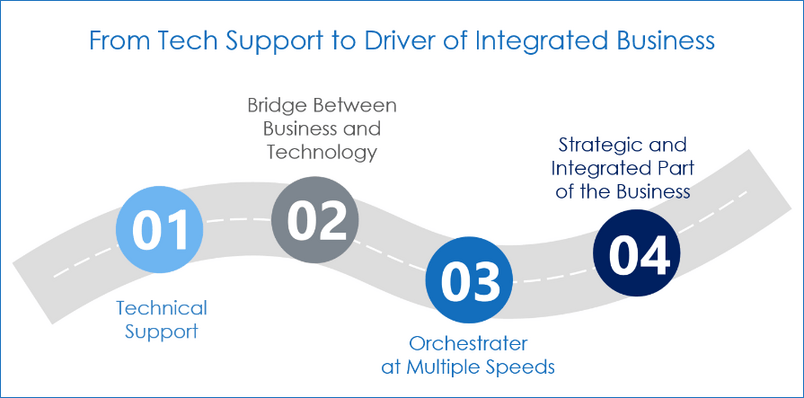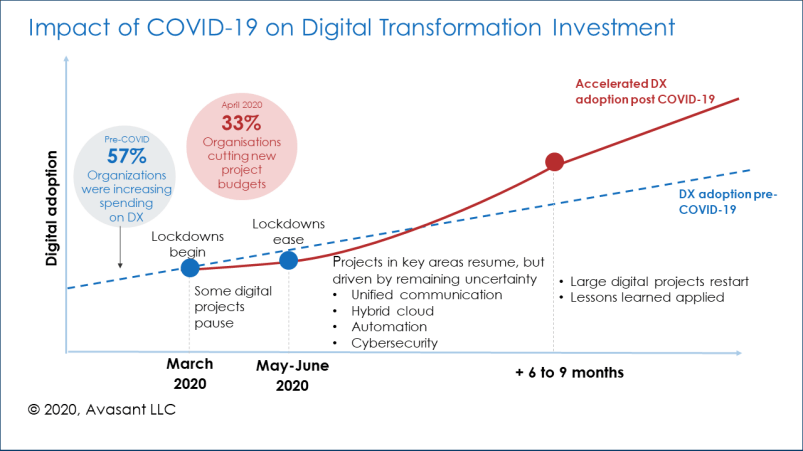By Henry Guapo, Avasant Partner
June 18, 2020
The coronavirus pandemic has had a tremendous impact around the world. It has affected every aspect of business, from customer needs and interaction methods, to supply chains and ways of working. All organizations have had to adjust their operations in these areas in one form or another, simultaneously.
But what do IT organizations need to do as we emerge from the pandemic? The bottom line is that this crisis has highlighted the significance of a digital operating model and elevated the relevancy of many of the changes that were already underway – from cloud to automation to agile operations. While the post-COVID world may bring about a new normal, organizations can adapt to it by accelerating their digital transformation initiatives.
One big lesson learned among Avasant clients during the past few months is that those who already had an integrated digital operating model had far better outcomes working through the pandemic. Such an operating model is simply better suited to respond to any situation requiring agility, speed, and resiliency.
For IT organizations lagging in their digital transformation journey, the post-COVID world means taking the steps necessary to adopt the organizational and operational frameworks of a fully integrated operating model.
This was a key theme in our recent digital forum, “Reality Check: How to Reshape Your IT Organization – A CIO Perspective,” moderated by Naresh Lachmandas, Principal at Avasant, along with Steve Phillpott, Western Digital CIO, and Tony Costa, Bumble Bee Foods CIO, who reported on their organizational efforts in working through the crisis. Larry Godec, chairman of the TBM Council, also participated in the forum.

From Tech Support to Strategic Business Partner
To understand where we are going, it’s instructive to take a trip down IT memory lane to review the spectrum of roles IT organizations have played in the enterprise, starting from when the IT department handled mostly tech support—to IT becoming an integrated driver of business value, as shown in the figure above.
-
- Stage 1: In the early years of IT, and with some organizations still today, IT is basically seen as a provider of tech support, with minimal collaboration between the business and the IT organization, with delivery taking place in a waterfall approach.
- Stage 2: This is the “bridge” stage, where the business and IT begin to work harder at alignment. There is more focus on IT strategy to support the business strategy, with standardized and structured solutions delivered at scale. However, without tighter integration, this can easily result in IT and the business continuing to operate in their separate silos.
- Stage 3: Here the enterprise recognizes the strategic importance of digital transformation, and IT becomes an “orchestrator,” able to operate at multiple speeds, depending on the need.
The majority of Avasant clients recognize the strategic importance of digital transformation and have matured their role in the enterprise and in a supporting IT operating model to get them to Stage 3. At this stage, the enterprise and IT recognize the importance of speed and flexibility. IT applies agile principles and operates front-end, customer-facing systems with speed and agility, while back-end systems evolve more slowly, emphasizing stability. However, this can result in conflicts when front-end systems need to interact with the back end in real time. In addition, the need for speed and flexibility directly conflicts with Stage 2’s highly standardized and structured methods of operating, which tend to remain in Stage 3 IT organizations.
Only when organizations reach Stage 4 do they realize holistic and integrated digital transformation. At this stage, the IT organization displays four key characteristics:
-
- Business Leadership: The enterprise views technology as the backbone, and IT is a key driver of the overall business strategy
- Value Driven: IT is an active force in solving business problems, with success measured by the value achieved
- Collaborative and Data Driven: IT connects the enterprise, and it looks ahead, based on real-time data and analytics
- Speed and Agility: IT operates at market speed and can be as innovative as the technologies that permeate the enterprise.
These characteristics are supported and delivered through several roles, processes, and technologies, and most importantly integrated business and IT operating methods, which drive focus on improving customer experiences and operations from the perspective of an end-to-end value stream. This is the key ingredient that allowed Stage 4 organizations to achieve better COVID-19 response outcomes.
Bumble Bee’s Blockchain Project Blossoms
Tony Costa of Bumble Bee Foods shared one example of how the IT organization stepped up to lead the business with an innovative digital solution that added value to the business and for its customers.
“We did this ocean-to-table blockchain project about a year ago,” Costa said. “What started off as a global supply-chain project morphed into a robust, ocean-to-table blockchain project, where we did co-innovation with SAP. … You develop projects and implement technologies and go on these journeys, not for anticipating a COVID transition, but because of what we feel is important to our customers.
Back in the day, there was so much hype around blockchain. But use cases weren’t always apparent. Fast forward to where we’re at today, it’s tangible. More than ever, consumers want to know where their food came from. They want to know what’s sustainably sourced and that it’s healthy. And [with the blockchain system] we’re fully transparent and provide the traceability.”
Costa said the blockchain project is an example of what IT leaders need to do. “Whatever stage you’re in, you’ve got to have strong leadership in the business,” he said.
Digital Twins Boost Robot Efficiency at Western Digital
Steve Phillpott, CIO of storage giant Western Digital, provided an example of how it executes on generating real time data to adjust its operations also in real time. Through the use of artificial intelligence and machine learning, Western Digital was able to use data to optimize lights-out factory operations.
Specifically, the solution employs “digital twins,” which allow a manufacturer to create the virtual equivalent of a production environment. Western Digital produces millions of hard drives and flash-based devices a year, and the use of digital twins is a way it can analyze manufacturing processes, identify bottlenecks, and run various tests without incurring excessive overhead.
Costa said:
“We use a digital twin of one of our factories. The factory is what we call a lights-out factory. There’s virtually nobody in there, and it’s run by robots. But what the digital twin does is it allows us to make a virtual image of a physical warehouse. And then we can optimize how those robots move.
The thought process is … we have expensive capital test equipment. You never want it waiting for a robot. You always want the robot waiting for expensive test equipment. And we use machine learning and AI within this digital twin to optimize the movements of those robots. And we’ve improved. We’ve seen about a 25-plus percent improvement in the efficiency of the robots since we did the digital twin initiative. And now, with the success at that one factory, we’re looking at moving that out to other factories.”
Costa said the company is realizing many benefits from investments in digital twins and automation, and the company continues to pursue new opportunities to reduce cost, increase compliance, improve satisfaction, and boost its competitive advantage.
Time for Acceleration
The pandemic has thrown a wrench into many a company’s technology plans. In the short term, many companies responded to the pandemic by cutting back on new projects, including digital transformation initiatives. But in the longer term, as we come out of the crisis, digital transformation initiatives will accelerate faster than before the pandemic. More specifically, large-scale digital projects will restart, digital investments will scale up, and lessons learned will be applied. More companies will understand that digital-driven innovation is an imperative to stay ahead of the competition.

Although the pandemic may be putting the brakes on new projects, we expect digital transformation efforts to accelerate in the coming months as we emerge from the crisis, as shown in the figure above. Our surveys find that although 33% of IT organizations are cutting their IT spending in response to the pandemic, the spending reductions are small thus far, only in the 10% to 15% range, and largely focused on capital spending and new initiatives paused due to uncertainty.
Once lockdown restrictions are lifted, we expect digital transformation initiatives not only to be resumed but accelerated, as IT organizations seek agility and increasing business value in the post-COVID world. Prior to the pandemic, 57% of IT organizations were reporting increasing spend on digital transformation. As we apply lessons learned from organizations like Western Digital, with its data-driven operations, and Bumble Bee Foods, with IT showing business leadership, these investments can only increase.
Analysis by Henry Guapo, Avasant Partner, at Avasant’s Digital Forum, “Reality Check: How to Reshape Your IT Organization – A CIO Perspective.”
Download the presentation slides and Watch the video here.

